Unit 4 Don't eat in class. SectionA Grammar Focus-3c 课件 (共26张PPT)
文档属性
| 名称 | Unit 4 Don't eat in class. SectionA Grammar Focus-3c 课件 (共26张PPT) | 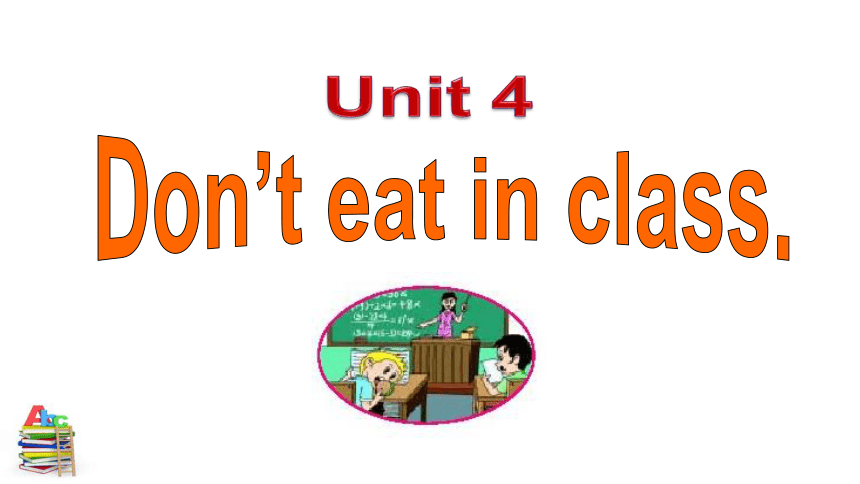 | |
| 格式 | pptx | ||
| 文件大小 | 3.1MB | ||
| 资源类型 | 教案 | ||
| 版本资源 | 人教新目标(Go for it)版 | ||
| 科目 | 英语 | ||
| 更新时间 | 2022-03-13 14:31:44 | ||
图片预览



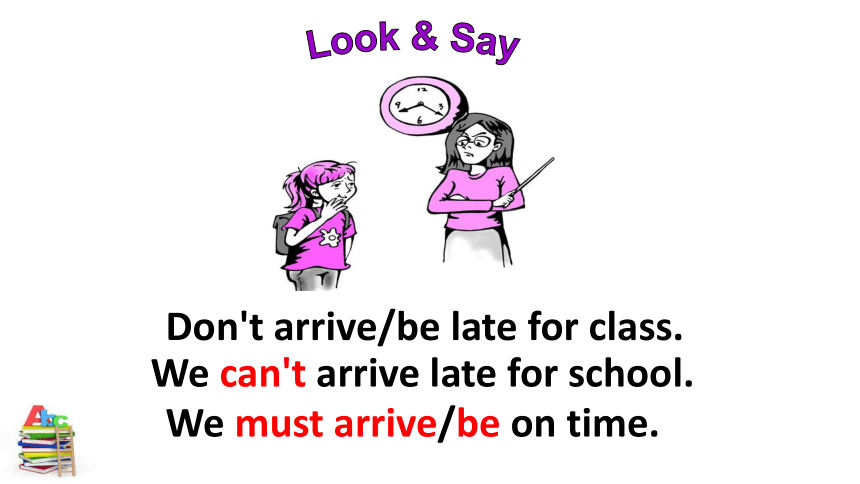
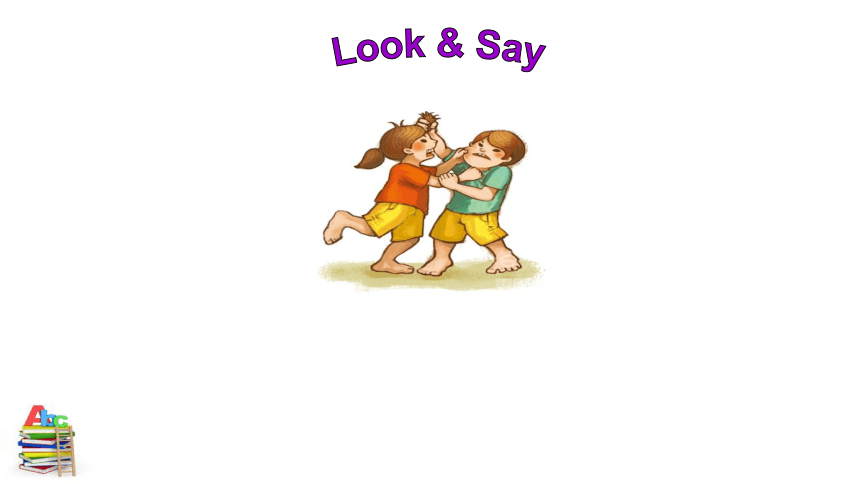
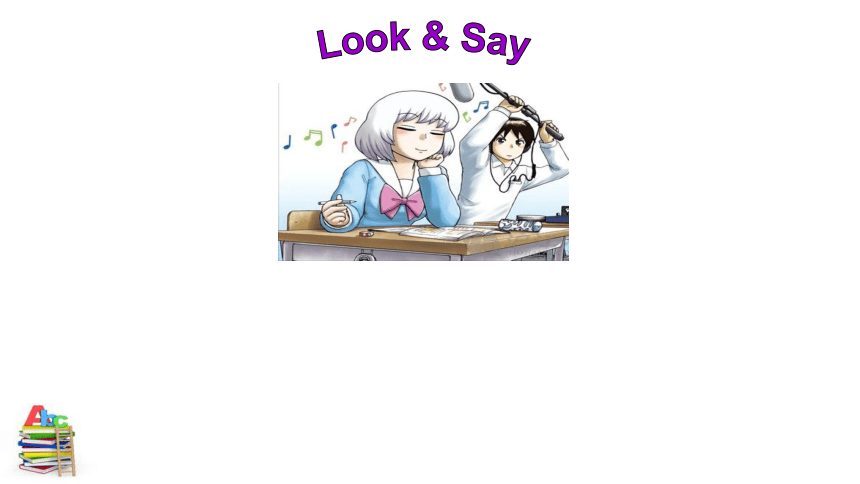

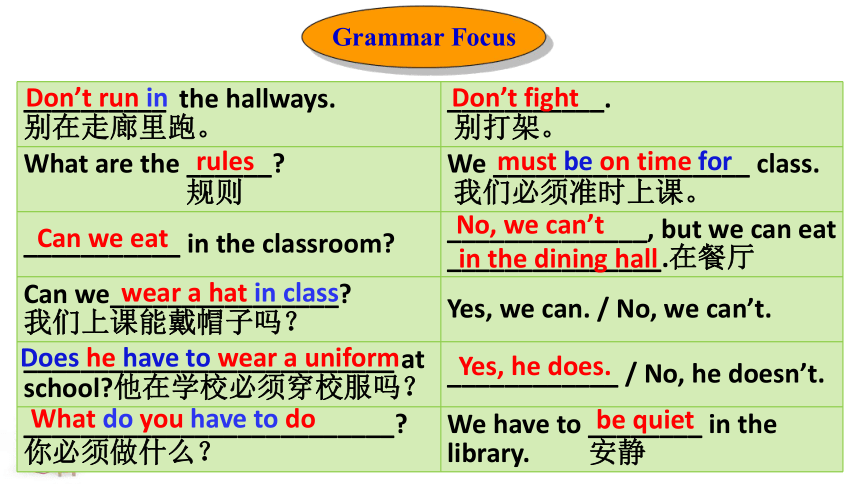
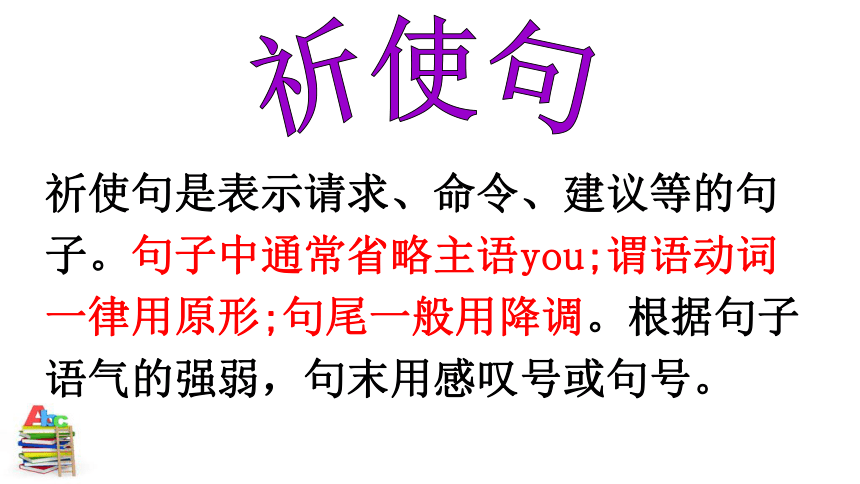
文档简介
(共26张PPT)
Don’t eat in class.
Don’t eat in class.
Unit 4
Section A2
Grammar Focus-3c
Look & Say
Don' t eat in class.
We can't eat in class.
We can/must eat in the dining hall.
Look & Say
We can't arrive late for school.
Don't arrive/be late for class.
We must arrive/be on time.
Look & Say
Look & Say
We have to wear
school uniforms.
Be quiet, please.
Don’t talk in class.
We can’t talk in class.
Choose your favorite letter, and say the rules.
rules
S
Don’t run in the hallways.
We can’t run in the hallways.
Don’t bring mobile
phone to school.
E
Don’t eat in the classroom.
We can eat in the dining hall.
L
R
U
__________ the hallways. 别在走廊里跑。 ___________.
别打架。
What are the ______ 规则 We __________________ class.
我们必须准时上课。
___________ in the classroom ______________, but we can eat _______________.在餐厅
Can we________________ 我们上课能戴帽子吗? Yes, we can. / No, we can’t.
__________________________ at school 他在学校必须穿校服吗? ____________ / No, he doesn’t.
__________________________ 你必须做什么? We have to ________ in the library. 安静
Grammar Focus
Don’t run in
Don’t fight
rules
must be on time for
Can we eat
No, we can’t
in the dining hall
wear a hat in class
Does he have to wear a uniform
Yes, he does.
What do you have to do
be quiet
祈使句是表示请求、命令、建议等的句子。句子中通常省略主语you;谓语动词一律用原形;句尾一般用降调。根据句子语气的强弱,句末用感叹号或句号。
祈使句
Be careful ! 小心!
Be quiet, please.请安静。
Wait here for me! 在这等我!
Come in, please! 请进!
Let’s see a film. 我们看电影吧。
Let’s go home. 我们回家吧。
Don’t talk in class! 不要在课常上讲话!
Don’t open the window! 别开窗!
Don’t be late for school. 上学别迟到 !
Don’t smoke! 别吸烟!
Don’t let him go. 不要让他走。
Let’s not go there. 咱们别去那儿
祈使句的肯定式
祈使句的否定式
以be动词开头,简称Be型。
以行为动词原形开头,简称Do型。
以Let开头,简称Let型。
注意:有时可在祈使句的句首或句尾加上please,使语气显得客气、有礼貌。如果在句尾加please,应该用逗号与前句隔开
Do型和Be型的否定式是在句首加don’t。
以let开头的祈使句,一种直接在句首加don’t,另一种是“let + 宾语 + not +动原+ (其他)”。
注意:“No+名词/动词ing形式”表示禁止或规劝,常用于公共场所。 e.g. No parking! 禁止停车! No smoking!禁止吸烟!
1) 肯定陈述句结构: 主语+have to+动词原形+其他
(一般现在时, 主语是第三人称单数时, 用has to; 句子是
过去时, 用had to)如:
情态动词have to 的用法
We have to wear sneakers for gym class.
在体育课上, 我们必须穿运动鞋。
Tom has to practice the guitar every day.
汤姆每天必须练习弹吉它。
I had to get up at 5:00 am last Monday.
上周一, 我不得不早上5点起床。
have to意思是“必须、不得不”, 它侧重于客观上的必
要和外界的权威。
2) 否定陈述句结构: 主语+don’t have to+动词原形+其他
(一般现在时, 主语是第三人称单数时, 用doesn’t have to;
句子是过去时, 用didn’t have to)如:
Nick doesn’t have to wear a uniform.
尼克不必穿校服。
We didn’t have to do our homework at once.
我们不必马上完成作业。
3) 一般疑问句结构: Do (Does 或 Did)+主语+have to
+动词原形+其他?如:
--Do you have to stay at home on weekends
--Yes, I do. / No, I don't.
--周末你必须待在家里吗?--是的, 我必须。/ 不, 我不必。
Did he have to go to bed by 11:00 last night
昨晚, 他不得不11点上床睡觉吗?
have to与must
的区别
区别1:must多表示主观需要或责任感的驱使有必要或有义务去做某事,多译为“必须”;而have to多表示客观存在的环境所限,即客观要求(无奈)而为之,多译为“不得不干某事”。
例: I must clean the room because it is too dirty. (无人强迫)
因为太脏了,我必须要打扫房间。
I have to leave school because my family is poor now. (无奈)
因为家里穷了,我不得不退学。
例: Daming was hurt. He had to stay in hospital .
大明受伤了。他得住院。
He has to go to take care of his sister.
他得照顾他妹妹。
We don’t have to go to school on Sundays.
星期天我们不必上学。
区别2: must 没有人称和时态的变化,而have to 有人称和时态的变化。
He doesn’t have to do it.
他不必做那件事。
He mustn’t do it.
他不许做那件事。
You mustn't waste your time.
你不应该浪费时间。
区别3: have to 否定为don’t / doesn’t /didn’t have to,表示“没有必要”;must 的否定为must not(mustn't) ,表示“不允许”、“不应该”、“禁止” 的意思,语气比较强烈。
Does he have to do it
他不得不做那件事吗?
Must he do his homework
他必须做他的作业吗?
区别4:含有have to的句子变一般疑问句或否定句时要借助助动词do 或does ;而含有must的句子变一般疑问句是直接将must提前至句首。
1.---Must I finish my homework before eight o’clock
---Yes,you must.
---我必须要在8点之前完成作业吗 ---是的,必须。
2.---Must I attend the meeting
---No,you needn’t/don’t have to.
我必须要参加这次会议吗 .不。你不必。
区别5:由must引起的疑问句,肯定回答要用must或have to,否定回答要用needn’t或don’t have to,意思是“不必”。
1. He has to wear the school uniform at school. (一般疑问句)
_____ he ________ wear the school uniform at school
2. They have to do too much homework every day. (否定句)
They ____________ do too much homework every day.
3. We must finish our work now. (改为一般疑问句)
_____ we _____ our work now
4.---______we hand in our exercise books today
---Yes, you _____.是的,必须今天交。
---No, you ____________________.不必今天交。
Does
have to
don’t have to
Must
finish
根据要求完成下列各题。
Must
must
needn't\don't have to
用have to, must 填空。
1. It’s cold outside. We ______ stay at home.
2. We ____ be good with our parents.
have to
must
Library Rules
1.Don’t talk.
2. ________________
3. ________________
4. ________________
Write the rules for the school library.
Don’t listen to music.
Don’t eat or drink.
Don’t take photos.
3a
No photos.
Use the words to make questions about the rules. Then write answers according to your school.
3b
1.Be quiet (she/have to /in the library)
Q: Does she have to be quiet in the library
A: Yes, she does.
2. Eat (he/have to/in the dining hall)
Q: ________________________________
A: _____________
3. Listen to music (we/can/in the hallways)
Q: ________________________________
A: _____________
4. Wear a hat (we/can/in the classroom)
Q: _____________________________
A: ____________
Yes, he does.
Does he have to eat in the dining hall
Can we listen to music in the hallways
No, we can’t.
Can we wear a hat in the classroom
No, we can’t.
No, we can’t.
We can eat in class.
We don’t have to come to school every day.
…
Make up five cool rules for your dream school. Share your rules with the class. Your classmates vote for the Coolest School!
At my dream
school, we don’t have to come to school every day. We …
3c
At my dream school, we don’t have to come to school every day. …
We can eat in class …
We don’t have to wear school uniforms …
We can listen to music in class…
We can eat in the classroom. …
We don’t have to do homework. …
At my dream school, we don’t have to come to school every day. We can eat in the classroom.
We can listen to music in class.
We don’t have to do homework.
We don’t have to wear school uniforms at school.
Report
Great! Jim’s school is the coolest.
Thank you !
Don’t eat in class.
Don’t eat in class.
Unit 4
Section A2
Grammar Focus-3c
Look & Say
Don' t eat in class.
We can't eat in class.
We can/must eat in the dining hall.
Look & Say
We can't arrive late for school.
Don't arrive/be late for class.
We must arrive/be on time.
Look & Say
Look & Say
We have to wear
school uniforms.
Be quiet, please.
Don’t talk in class.
We can’t talk in class.
Choose your favorite letter, and say the rules.
rules
S
Don’t run in the hallways.
We can’t run in the hallways.
Don’t bring mobile
phone to school.
E
Don’t eat in the classroom.
We can eat in the dining hall.
L
R
U
__________ the hallways. 别在走廊里跑。 ___________.
别打架。
What are the ______ 规则 We __________________ class.
我们必须准时上课。
___________ in the classroom ______________, but we can eat _______________.在餐厅
Can we________________ 我们上课能戴帽子吗? Yes, we can. / No, we can’t.
__________________________ at school 他在学校必须穿校服吗? ____________ / No, he doesn’t.
__________________________ 你必须做什么? We have to ________ in the library. 安静
Grammar Focus
Don’t run in
Don’t fight
rules
must be on time for
Can we eat
No, we can’t
in the dining hall
wear a hat in class
Does he have to wear a uniform
Yes, he does.
What do you have to do
be quiet
祈使句是表示请求、命令、建议等的句子。句子中通常省略主语you;谓语动词一律用原形;句尾一般用降调。根据句子语气的强弱,句末用感叹号或句号。
祈使句
Be careful ! 小心!
Be quiet, please.请安静。
Wait here for me! 在这等我!
Come in, please! 请进!
Let’s see a film. 我们看电影吧。
Let’s go home. 我们回家吧。
Don’t talk in class! 不要在课常上讲话!
Don’t open the window! 别开窗!
Don’t be late for school. 上学别迟到 !
Don’t smoke! 别吸烟!
Don’t let him go. 不要让他走。
Let’s not go there. 咱们别去那儿
祈使句的肯定式
祈使句的否定式
以be动词开头,简称Be型。
以行为动词原形开头,简称Do型。
以Let开头,简称Let型。
注意:有时可在祈使句的句首或句尾加上please,使语气显得客气、有礼貌。如果在句尾加please,应该用逗号与前句隔开
Do型和Be型的否定式是在句首加don’t。
以let开头的祈使句,一种直接在句首加don’t,另一种是“let + 宾语 + not +动原+ (其他)”。
注意:“No+名词/动词ing形式”表示禁止或规劝,常用于公共场所。 e.g. No parking! 禁止停车! No smoking!禁止吸烟!
1) 肯定陈述句结构: 主语+have to+动词原形+其他
(一般现在时, 主语是第三人称单数时, 用has to; 句子是
过去时, 用had to)如:
情态动词have to 的用法
We have to wear sneakers for gym class.
在体育课上, 我们必须穿运动鞋。
Tom has to practice the guitar every day.
汤姆每天必须练习弹吉它。
I had to get up at 5:00 am last Monday.
上周一, 我不得不早上5点起床。
have to意思是“必须、不得不”, 它侧重于客观上的必
要和外界的权威。
2) 否定陈述句结构: 主语+don’t have to+动词原形+其他
(一般现在时, 主语是第三人称单数时, 用doesn’t have to;
句子是过去时, 用didn’t have to)如:
Nick doesn’t have to wear a uniform.
尼克不必穿校服。
We didn’t have to do our homework at once.
我们不必马上完成作业。
3) 一般疑问句结构: Do (Does 或 Did)+主语+have to
+动词原形+其他?如:
--Do you have to stay at home on weekends
--Yes, I do. / No, I don't.
--周末你必须待在家里吗?--是的, 我必须。/ 不, 我不必。
Did he have to go to bed by 11:00 last night
昨晚, 他不得不11点上床睡觉吗?
have to与must
的区别
区别1:must多表示主观需要或责任感的驱使有必要或有义务去做某事,多译为“必须”;而have to多表示客观存在的环境所限,即客观要求(无奈)而为之,多译为“不得不干某事”。
例: I must clean the room because it is too dirty. (无人强迫)
因为太脏了,我必须要打扫房间。
I have to leave school because my family is poor now. (无奈)
因为家里穷了,我不得不退学。
例: Daming was hurt. He had to stay in hospital .
大明受伤了。他得住院。
He has to go to take care of his sister.
他得照顾他妹妹。
We don’t have to go to school on Sundays.
星期天我们不必上学。
区别2: must 没有人称和时态的变化,而have to 有人称和时态的变化。
He doesn’t have to do it.
他不必做那件事。
He mustn’t do it.
他不许做那件事。
You mustn't waste your time.
你不应该浪费时间。
区别3: have to 否定为don’t / doesn’t /didn’t have to,表示“没有必要”;must 的否定为must not(mustn't) ,表示“不允许”、“不应该”、“禁止” 的意思,语气比较强烈。
Does he have to do it
他不得不做那件事吗?
Must he do his homework
他必须做他的作业吗?
区别4:含有have to的句子变一般疑问句或否定句时要借助助动词do 或does ;而含有must的句子变一般疑问句是直接将must提前至句首。
1.---Must I finish my homework before eight o’clock
---Yes,you must.
---我必须要在8点之前完成作业吗 ---是的,必须。
2.---Must I attend the meeting
---No,you needn’t/don’t have to.
我必须要参加这次会议吗 .不。你不必。
区别5:由must引起的疑问句,肯定回答要用must或have to,否定回答要用needn’t或don’t have to,意思是“不必”。
1. He has to wear the school uniform at school. (一般疑问句)
_____ he ________ wear the school uniform at school
2. They have to do too much homework every day. (否定句)
They ____________ do too much homework every day.
3. We must finish our work now. (改为一般疑问句)
_____ we _____ our work now
4.---______we hand in our exercise books today
---Yes, you _____.是的,必须今天交。
---No, you ____________________.不必今天交。
Does
have to
don’t have to
Must
finish
根据要求完成下列各题。
Must
must
needn't\don't have to
用have to, must 填空。
1. It’s cold outside. We ______ stay at home.
2. We ____ be good with our parents.
have to
must
Library Rules
1.Don’t talk.
2. ________________
3. ________________
4. ________________
Write the rules for the school library.
Don’t listen to music.
Don’t eat or drink.
Don’t take photos.
3a
No photos.
Use the words to make questions about the rules. Then write answers according to your school.
3b
1.Be quiet (she/have to /in the library)
Q: Does she have to be quiet in the library
A: Yes, she does.
2. Eat (he/have to/in the dining hall)
Q: ________________________________
A: _____________
3. Listen to music (we/can/in the hallways)
Q: ________________________________
A: _____________
4. Wear a hat (we/can/in the classroom)
Q: _____________________________
A: ____________
Yes, he does.
Does he have to eat in the dining hall
Can we listen to music in the hallways
No, we can’t.
Can we wear a hat in the classroom
No, we can’t.
No, we can’t.
We can eat in class.
We don’t have to come to school every day.
…
Make up five cool rules for your dream school. Share your rules with the class. Your classmates vote for the Coolest School!
At my dream
school, we don’t have to come to school every day. We …
3c
At my dream school, we don’t have to come to school every day. …
We can eat in class …
We don’t have to wear school uniforms …
We can listen to music in class…
We can eat in the classroom. …
We don’t have to do homework. …
At my dream school, we don’t have to come to school every day. We can eat in the classroom.
We can listen to music in class.
We don’t have to do homework.
We don’t have to wear school uniforms at school.
Report
Great! Jim’s school is the coolest.
Thank you !
同课章节目录
- Unit 1 Can you play the guitar?
- Section A
- Section B
- Unit 2 What time do you go to school?
- Section A
- Section B
- Unit 3 How do you get to school?
- Section A
- Section B
- Unit 4 Don't eat in class.
- Section A
- Section B
- Unit 5 Why do you like pandas?
- Section A
- Section B
- Unit 6 I'm watching TV.
- Section A
- Section B
- Review of Units 1-6
- Unit 7 It's raining!
- Section A
- Section B
- Unit 8 Is there a post office near here?
- Section A
- Section B
- Unit 9 What does he look like?
- Section A
- Section B
- Unit 10 I'd like some noodles.
- Section A
- Section B
- Unit 11 How was your school trip?
- Section A
- Section B
- Unit 12 What did you do last weekend?
- Section A
- Section B
